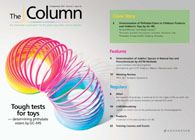Red, red wine
The cardiovascular benefits of drinking red wine are well known but far less well known are the mechanisms behind this effect. A new study into red wine polyphenols has suggested that they may be helping to protect omega-3 fatty acids from breaking down in the body.1

The cardiovascular benefits of drinking red wine are well known but far less well known are the mechanisms behind this effect. A new study into red wine polyphenols has suggested that they may be helping to protect omega-3 fatty acids from breaking down in the body.1
Red wine is a natural source of polyphenols, a group of chemicals associated with decreased risk of cardiovascular disease, cancer and other chronic illnesses. A study, published in Food Research International, has investigated the effects of the polyphenols from red wine on the human plasma fatty acids and their oxidization, particularly looking at those involved in the inflammatory response.
The oxidizability of the major fatty acids in plasma was determined by measuring their deterioration by gas chromatography. The study found that the polyphenols increased the resistance to peroxidation of the omega-3 fatty acids involved in the inflammatory response compared with omega-6 acids. It was suggested that the results could show the wine polyphenols are making the acids less accessible to hydro-soluble radicals, providing a biochemical rationale for future studies on these potential health benefits.
1. R. Cazzola and B. Cestaro, Food Research International (in press).
This story originally appeared in The Column. Click here to view that issue.
Determining Enhanced Sensitivity to Odors due to Anxiety-Associated Chemosignals with GC
May 8th 2025Based on their hypothesis that smelling anxiety chemosignals can, like visual anxiety induction, lead to an increase in odor sensitivity, a joint study between the University of Erlangen-Nuremberg (Erlangen, Germany) and the Fraunhofer Institute for Process Engineering and Packaging (Freising, Germany) combined behavioral experiments, odor profile analysis by a trained panel, and instrumental analysis of odorants (gas chromatography-olfactometry) and volatiles (gas chromatography-mass spectrometry).
Investigating 3D-Printable Stationary Phases in Liquid Chromatography
May 7th 20253D printing technology has potential in chromatography, but a major challenge is developing materials with both high porosity and robust mechanical properties. Recently, scientists compared the separation performances of eight different 3D printable stationary phases.
Detecting Hyper-Fast Chromatographic Peaks Using Ion Mobility Spectrometry
May 6th 2025Ion mobility spectrometers can detect trace compounds quickly, though they can face various issues with detecting certain peaks. University of Hannover scientists created a new system for resolving hyper-fast gas chromatography (GC) peaks.

.png&w=3840&q=75)

.png&w=3840&q=75)



.png&w=3840&q=75)



.png&w=3840&q=75)









